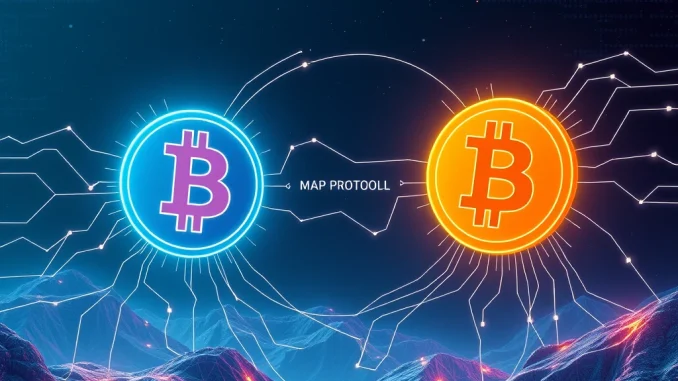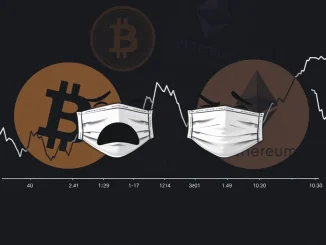
Big news shaking up the crypto world! Imagine moving assets and interacting with applications across major blockchains like Bitcoin and Solana without relying on complicated, centralized methods. That future is getting closer thanks to the latest announcement from MAP Protocol.
Connecting disparate blockchain networks has long been a significant challenge in the crypto space. Each chain operates within its own ecosystem, making it difficult for assets and data to flow freely between them. This fragmentation limits liquidity and hinders the overall growth of the decentralized web. The demand for robust, secure, and truly decentralized cross-chain interoperability has never been higher.
What is MAP Protocol and Why is this Launch Important?
At its core, MAP Protocol positions itself as a Bitcoin layer-2 and a peer-to-peer omnichain infrastructure. Think of it as a bridge builder for the blockchain world, specifically designed with Bitcoin’s security principles in mind while enabling connections to virtually any other chain.
Their recent announcement, shared via their official X account, marks a pivotal moment: the successful launch of direct cross-chain functionality between the Bitcoin and Solana networks. This isn’t just about sending a token from one chain to another; it’s about enabling decentralized transactions and interactions that were previously complex or impossible between these two specific ecosystems.
Why is this pairing particularly noteworthy?
- Bitcoin: The largest, most secure, but traditionally least programmable blockchain.
- Solana: A high-speed, low-cost blockchain ecosystem with a rapidly growing DeFi and NFT scene.
Bridging these two opens up immense possibilities, combining Bitcoin’s store-of-value strength with Solana’s transactional efficiency and dApp variety.
Achieving Seamless Bitcoin Cross-Chain Transactions
For Bitcoin holders, this launch means potential new avenues for utilizing their assets. Historically, getting Bitcoin liquidity into other ecosystems required wrapped tokens (like wBTC) or centralized exchanges, adding layers of trust assumptions and complexity. The goal of Bitcoin cross-chain solutions like the one offered by MAP Protocol is to reduce or eliminate these dependencies.
While the technical specifics involve cryptographic proofs and validators on the MAP Protocol network verifying actions on both the Bitcoin and Solana chains, the user experience aims to be straightforward. Imagine being able to participate in Solana’s DeFi protocols using your native BTC, or seamlessly swap between BTC and SOL assets in a decentralized manner, all facilitated by the underlying MAP infrastructure.
Unlocking Possibilities with Solana Cross-Chain Connectivity
On the flip side, the launch of Solana cross-chain capabilities via MAP Protocol brings significant advantages to the Solana ecosystem. It allows Solana users and applications to tap into the vast liquidity and established presence of the Bitcoin network. This connection can potentially onboard new users from the Bitcoin community into Solana’s vibrant dApp landscape.
Developers building on Solana can now explore creating applications that interact directly with Bitcoin assets or data streams verified through the MAP Protocol. This expands the design space for decentralized applications, leading to more sophisticated and interconnected services that aren’t confined to a single blockchain.
The Power of Cross-Chain Interoperability for Users
The core benefit of this development lies in true cross-chain interoperability. For the end-user, this translates into:
- Increased Liquidity: Easier movement of assets between chains means liquidity isn’t siloed.
- Access to Diverse Opportunities: Participate in DeFi, NFTs, or other applications on different chains without needing to sell and re-buy assets.
- Decentralization: Reducing reliance on centralized exchanges or custodial wrapping services for cross-chain movements.
- Improved User Experience: Over time, cross-chain solutions aim to make interacting with multiple blockchains feel less fragmented.
This move by MAP Protocol contributes to a more connected and efficient decentralized ecosystem.
Exploring the Omnichain Future with MAP
MAP Protocol describes itself as an omnichain infrastructure. This term goes beyond simple bridging; it suggests a future where different blockchains function together as a single, cohesive network from the user’s perspective. An omnichain approach aims to allow users and dApps to interact with assets and protocols across *any* connected chain seamlessly, without needing to worry about the underlying blockchain they are currently on.
Connecting Bitcoin and Solana is a major step towards this omnichain vision. By successfully linking two networks with vastly different architectures and consensus mechanisms, MAP Protocol demonstrates the potential for building a truly interconnected blockchain future where value and data can flow freely and securely across the entire decentralized landscape.
What’s Next?
While the announcement confirms the technical launch, the real impact will be seen as developers and users begin to utilize this new functionality. Keep an eye on dApps and platforms integrating MAP Protocol’s solution to offer direct Bitcoin-Solana interactions. Security in cross-chain solutions is paramount, and observing how the protocol handles transaction verification and potential vulnerabilities will be crucial.
Conclusion
MAP Protocol’s launch of cross-chain interoperability between Bitcoin and Solana is a significant step forward for the decentralized web. By enabling decentralized transactions and interactions between these two major networks, they are helping to break down the silos that currently exist between blockchains. This move towards true cross-chain and omnichain capabilities promises a future where liquidity flows freely, users have access to a wider range of opportunities, and the blockchain ecosystem is more connected and robust than ever before. It’s an exciting development to watch as the industry moves closer to a seamlessly interconnected digital future.



